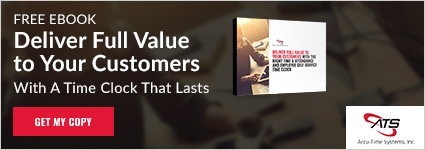The central questions you have to ask when looking for a time clock partner are:
- What value does this partner bring to my business?
- What value does this partner bring to my customers?
These are big questions that we’ve addressed before. We’ve detailedwhat to look for in a time clock partner to what questions toask your customers to help them select the best terminal for their business goals. These posts focus on the high-level issue of how you and your customers can realize quantifiable business value from choosing the right partner or right time clock.
Now it’s time to dig deeper into how a partner’s time clocks will integrate with your solution. Added revenue for you or cost-savings for your customer are valuable. However, our experience also tells us that the scope of the integration, and how easy it is to set up and maintain, are also key values. Partners are supposed to make your life easier. A time clock integration partner can't provide that with a slow or inelegant integration.
Here are five questions you need to ask any potential time clock partner:
1. What data – exactly – can be collected and shared?
Don’t make assumptions about what data a terminal integration can collect and share with the necessary back-end systems. Some data points that seem fundamental to you and your customers may not be collectible through a specific vendor's terminals. For example, does the time clock collect the daily tip amounts or attestations?
2. Is it a direct time clock integration or does it occur by sharing flat data files?
We were not surprised to learn that some time clocks still integrate with time and attendance systems by generating flat files for import. While a flat file integration eliminates the slow, error-prone manual process, it doesn’t provide full value that today’s technology allows. A nightly batch update means there’s no real-time data integration. It also creates a new point of failure that would affect an entire day’s worth of data, if a file gets corrupted. While flat files or hard coding lists may be fine for static data, such as department or role names, it’s insufficient for the daily employee-level information collected.
For example, a company that wants to keep overtime pay to a minimum needs to know in real-time who’s close to working too many hours. With multiple daily data updates, a manager can see if a worker enters an overtime red zone. A nightly batch will only see unauthorized overtime hours in hindsight, not prevent them.
3. How often is data shared between time clocks and back-end systems? Can the customer set its preferred cycle-time?
This is where you can dig deeper on time clock vendors that do offer direct integration rather than only flat files. In some cases, the data sharing cycle may be too slow to meet a customer's business needs, such as just running once or twice a day. In other cases, a customer may not want it to run too often so as not to overload the network.
The point here is that a valuable time clock partner will offer you and your customers options regarding data integration intervals. Integrations should run on your customers’ schedules, not the time clocks.
4. How do time clock software upgrades get deployed? Who does it? Does it involve any downtime?
Smooth, stress-free software upgrades are a must in this era of continual updates and innovations. This is essential to being a partner that makes both your life and your customers’ lives easier. Providing remote software and OS upgrades are just one service you should expect from a time clock partner.
5. Does the time clock vendor offer a cloud-based integration option?
Like so many business functions, workforce and human capital management functions are migrating to the cloud. You know that you're part of that migration. Your time clock partner should be too. A cloud-based integration, such as ATS’s Accu-Cloud solution, lets you deploy time clocks and their integration to new customers quickly and effectively using our proven process. ATS handles all the heavy-lifting of the time clock configuration and provisioning, while you can do what they do best: Sell your software along with the promise of a smooth time clock integration.
(Ask us how you can learn more about what Accu-Cloud can do here).
Time clock integrations all come down to whether they're making your and your customers' lives easier or adding a new source of stress to your operations. When asking a potential terminal partner about how it can integrate with your solution, get the details that exhibit precisely how the integration will add value and ease to implementations of your software. If you can't see it, your customers won't either, and that will reflect on your solution.

"While ATS is passionate about time and attendance and excited to support organizations navigate workforce dynamics around timekeeping, we recommend you reach out to your country, regional and/or local HR chapter for more information on common workplace advice and procedures."



